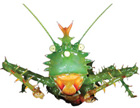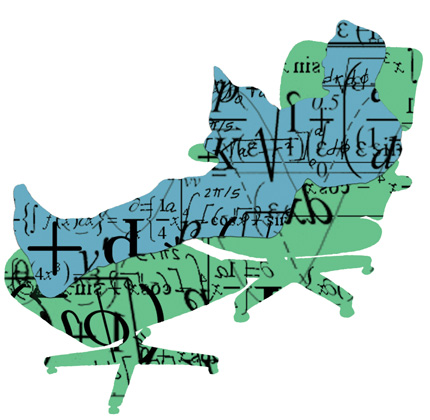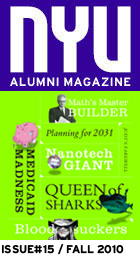Cutting-Edge Research
biology
A Biodiversity Cornucopia—For Now
by Kyle Leighton / GSAS ’10
It’s a bit of serendipity that Ecuador’s Yasuní National Park is located between the Napo and Curaray rivers, tributaries of the mighty Amazon. That particular spot gets lots of moisture, which has kept the rain forest there lush even as surrounding regions have dried up due to climate change and have been imperiled by cultivation and development. Scientists say that, as a result of this good fortune, Yasuní is arguably the most biodiverse place on Earth.
New evidence of this was recently published in the scientific journal PLoS ONE, where co-author and NYU primatologist Anthony Di Fiore revealed that the species in Yasuní eclipse an array of world biodiversity records. For example, the Tiputini Biodiversity Station, located on the northern rim of Yasuní, is home to 247 types of amphibians and reptiles, 550 bird species, and more than 100 types of bats. A single hectare of forest in Yasuní is estimated to contain 100,000 different types of insects, as well as a whopping 655 species of trees—more trees than are native to the continental United States and Canada combined.

But it may not last. Di Fiore notes that oil exploration within the park and creeping development on its outskirts now threaten this refuge. The Ecuadorian government has proposed halting the oil extraction, asking the international community to compensate them for 50 percent of the projected lost revenue, which would total nearly $3 billion over the next decade. So far there have been no takers, prompting President Rafael Correa to unveil an alternative plan to conduct more “environmentally safe” drilling.

This is still not encouraging to Di Fiore, who says that man’s influence will eventually be compounded by nature’s, as climate change increases and any effect on the park’s habitat could eliminate the opportunity to document unknown species of plants and animals. “Most models that look at climate change envision a drying up of the eastern Amazon,” he says. “And if you lose the west of the Amazon to human impact, then you’ve lost everything.”
social work
Friendly Barriers
by Emily Nonko / CAS ’10
For a new college grad, “social capital” might be key to landing a job. It could also help one score free box seats to a Yankees game. But for marginalized groups, social capital—in other words, family and friends—can sometimes do more harm than good. In many cases, it’s actually “both helpful and hurtful,” explains Silver School of Social Work assistant professor Robert Hawkins, who studied how social capital has affected lower-income women in Boston and the victims of Hurricane Katrina in New Orleans.
Hawkins discovered that relationships with family and close friends were more likely to keep lower-income individuals in an economic rut. However, weaker and shorter-term relationships with teachers, service providers, or co-workers were more likely to be agents for positive change. The Boston study, titled “Fickle Families and the Kindness of Strangers,” published last spring in the Journal of Human Behavior in the Social Environment, revealed that families typically offer immediate emotional support for lower-income single mothers but don’t lighten their financial burden. In Hawkins’ New Orleans study, “Bonding, Bridging, and Linking,” he was able to better understand how social limitations work within a community struck by disaster. Ultimately, the interviews Hawkins conducted provided catharsis for his subjects, and possibly even some positive social capital. “For all these individuals, it was a very empowering process,” he says. “Many just were thankful they were allowed to tell their story.”
philanthropy
A Health-Care Catch-22
by Kevin Fallon / CAS ’09
Karen Grépin stood on a street in Ghana last year, looking at a brand-new AIDS treatment facility. Its manicured lawns and fresh facade starkly contrasted with the structure across the street—a decrepit residence hall for one of the few Ghanaian medical schools that, she says, “looked like something you would never want to step inside.” It’s an increasingly familiar dichotomy visible throughout Africa, and the focus of a recent study by Grépin, assistant professor of global health policy at the Robert F. Wagner Graduate School of Public Service.
Grépin collected data across 28 sub-Saharan countries. Her research has revealed that focusing health-care funding so intensely on HIV/AIDS programs in Africa is producing unintended consequences. Millions of dollars pour in from governments and nonprofit organizations each year, but the majority of money is earmarked specifically for funding of HIV/AIDS awareness, diagnosis, and treatment. “The buildings are being built, but they have to be for that particular disease area,” Grépin notes. Further complicating the matter, African countries must also reallocate scarce resources—doctors, nurses, facilities—within their already struggling health-care systems to implement the new large-scale HIV/AIDS programs.
As a result, Grépin discovered that in areas with increased HIV/AIDS disbursements, basic health-care coverage—such as vaccinations for children and maternal health—is declining. While HIV/AIDS funding remains essential for saving lives, Grépin suggests that African countries would be better served by investments to support medical schools and train community health professionals to administer necessary vaccines. “Millions of children die every year from preventable things,” she says. “We have the drugs. Now we just have to think about how to get them into their arms.”
psychology
Time to Remember

When it comes to learning, it’s a good idea to give yourself a break. That’s what graduate student Arielle Tambini and Lila Davachi, assistant professor in the department of psychology and the Center for Neural Science, discovered in a recent study. “We found that taking breaks after absorbing a lot of information strengthens your memory of that information,” Tambini explains.
This might seem like common sense, but previous studies have only tested memory consolidation during sleep. Tambini and Davachi were interested in how memory works when you lie quietly with your eyes closed—but remain awake. Participants tested were shown pairs of images followed by a period of rest, when they could think about anything they chose. A scanner was used to gauge the activity in the hippocampus and cortical regions of the brain; it revealed that the mind works specifically to consolidate memory of those images in that time.
The findings were published in a January issue of the journal Neuron, and other NYU researchers are now testing how different kinds of activities—such as reading and math—may interfere with memory consolidation during rest. Until then, Tambini says, “We now know recess is never a harmful thing.” —E.N.







